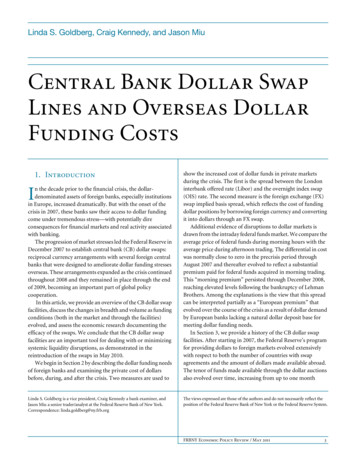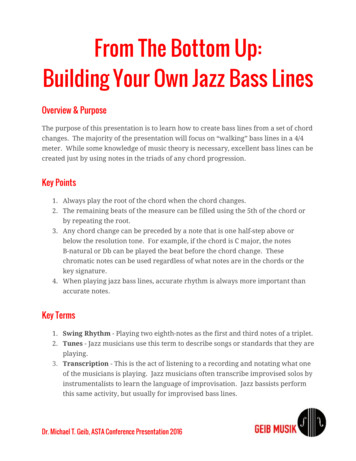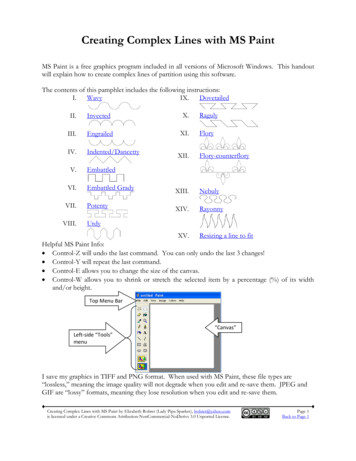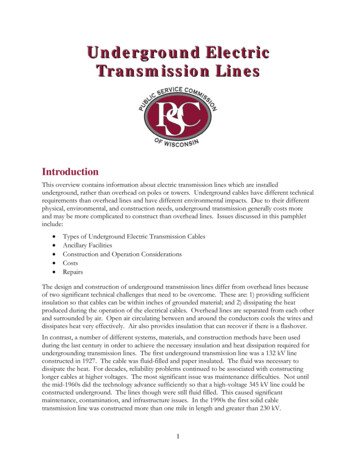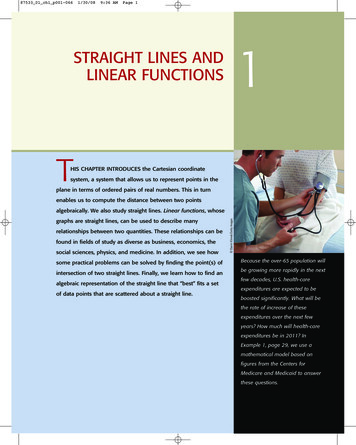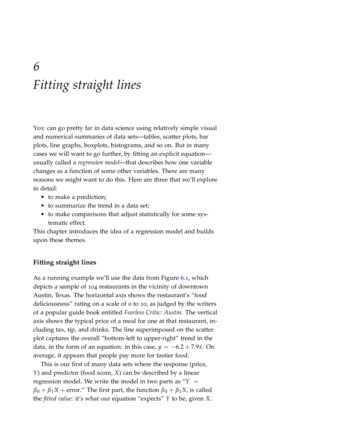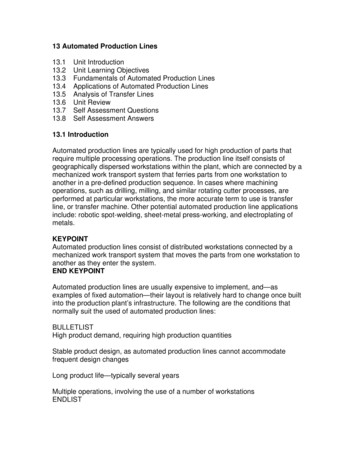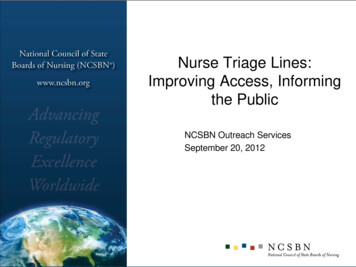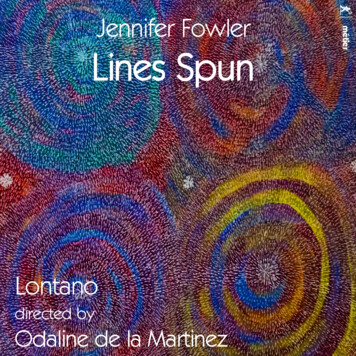
Transcription
Lines SpunMusic by JenniferFowler1Line Spun with Stars(flute, cello, piano)15:342Lady Maisry(soprano & piano)12:303Letter from Haworth(mezzo-soprano, clarinet, cello, piano)13:234 Streaming Up(flute, oboe, clarinet, cello, piano)7:315From the Cave Mouth(soprano, clarinet, violin)15:186Lament(oboe, clarinet, bassoon)8:36Total duration:Raphaela Papadakis sopranoLauren Easton mezzo-sopranoLontanodirected by Odaline de la Martinez72:54
The composerJennifer Fowler was born in Bunbury, Western Australia in 1939. She studied atthe University of Western Australia, where she won composition prizes and theUniversity’s Convocation Award. In 1968 she spent a year in Holland at theUniversity of Utrecht on a Dutch Government Scholarship. Since 1969, she hasbeen living in London where she works as a free-lance composer.Her international prizes for composition include:Academy of Arts, Berlin, 1970; Radcliffe Award of Great Britain, 1971;International Competition GEDOK, Mannheim, 1975; Miriam Gideon Prize,(USA) 2003; Bodman Memorial Competition, (UK) 2006; Sylvia GlickmanMemorial Prize, (USA) 2009 and Goleminov Contest, Bulgaria, 2009.Her output includes orchestral works, chamber pieces, solo music and vocalensembles of all kinds. Performances of works including some on this albumhave taken place recently in Australia, Hong Kong, Austria and the UK and hernew work Bassoon Solo was given its premiere at the London Festival of NewWind Music in October, 2018.Her music has been included in such prestigious international festivals as theISCM World Music Days; the Gaudeamus Music Week, Holland; theHuddersfield Festival of Contemporary Music, UK; the International SydneySpring Festival; the Perth International Arts Festival, Australia; City of LondonFestival; Women in Music festivals in London, Atlanta, Alaska, Melbourne,Sydney, Canberra, Rome, and Beijing; and the Australian Festival of ChamberMusic.Further information: www.impulse-music.co.uk/jenniferfowler
The music1Line Spun With StarsIn view of the vast choice of notes which one can use in a particular work, I liketo set some limits. In this piece I have limited myself to drawing a line; i.e. thepiece is almost entirely monophonic (one note at a time).There are episodes which have a characteristic pattern: a cluster of notes whichrevolve around a central note; a kind of "star" pattern, in which the central noteexerts a gravitational pull on the surrounding notes. Leading from one "star"pattern to another are lines with a strong sense of direction. They pull thestream of notes downwards or upwards, until encountering another starpattern.The impetus generated propels the piece either towards faster movement,reaching a burst of rapid notes; or towards slower movement, with longer notes.These cycles themselves vary in length and expand and contract.Because of these limits, the single stream of notes allows the patterns of tempoand direction to be etched out more distinctly.Lady MaisryThis is a setting of a traditional English verse, scored for soprano and piano. Thesetting was originally one of a group of four compositions which capturesignificant aspects of a woman's life, the kind of aspects which have alwaysoccurred and always will. In this verse, Lady Maisry is dying, possibly inchildbirth.
Lady MaisryOh she called her little page boyWho was her mother's son.She told him as quick as he could goTo bring the lord safe home.Come saddle, saddle my milk white steed,Come saddle my pony too,That I may neither eat nor drinkUntil I come to the castle new.Now the first mile he would walk,And the second he would run,And when he came to the broken bridge,He would bend his breast and swim.When he came to the new castle,He heard a big bell toll,And there he saw eight noble, noble men,A-bearing of a pall.When he came to the new castle,The lord was sat to meat,If you knew as much as me,How little, little would you eat.Lay down. lay down the gentle corpseAs it lies fast asleep,That I may kiss her red ruby lipsThat I used to kiss so sweet.Is my bower falling down,Or is my tower down?Or is my gay lady put to bedWith a daughter, or a son?Six times he kissed her red ruby lips,Nine times he kissed her chin,Ten times he kissed her snowy white breastWhich love did enter in.No, your bower is not falling down,Nor is your tower down,We are afraid before you return,Your lady will be dead and gone.The lady was buried on Sunday,Before the prayer was end.And the lord he died on the Sunday next,Before the prayer begun.
The music2Letter from HaworthThe text of Letter from Haworth comes from a letter which Charlotte Brontewrote in January 1845, to her friend and teacher, Monsieur Heger. During1842/3, Charlotte had studied languages at a school in Brussels run by MadameHeger. Her stay there was fraught with loneliness and homesickness so that herfriendship with Monsieur Heger – a lively and gifted teacher – assumed greatimportance.When she returned to Yorkshire, M. Heger corresponded with her for a time, ashe did with other ex-pupils, but it is obvious that a note of intensity in CharlotteBronte's replies, put him in a difficult position and his letters became more andmore infrequent. At the end of 1844 she had had no word for 6 months. Whenshe found that Mr Joe Taylor was planning to visit the continent to escort homehis sister Mary – a close friend – she asked him to carry a letter and place itpersonally into M. Heger's own hands, and to be the bearer of his reply.It was some months before the Taylors returned and when they did there wasno reply from her "master". She wrote, in an outburst of grief, the letter which Ihave set. It begins without the customary "Dear Monsieur"; without anygreeting at all:Mr Taylor has returned. I asked him if he had a letter for me. "No, nothing" .I found the idea of setting these words interesting, because of the tensionbetween the extremity of emotion conveyed, and the balance and control in theactual use of words. The letter is obsessed, but the intensity is contained in acontrolled rise and fall. Here is rhythm, and phrasing, and a limpid simplicitywhich belongs to the great writer that C.B. was to become.The piece was originally written in 1984, and revised in 2005.
Letter from HaworthMr Taylor has returned. I asked him if he had a letter for me. “No; nothing.” “Patience”, said I– “his sister will be here soon.” Miss Taylor has returned. “I have nothing for you fromMonsieur Heger” said she, “Neither letter nor message.”Having realised the meaning of these words, I said to myself what I should say to anothersimilarly placed: “You must be resigned, and above all do not grieve at a misfortune whichyou have not deserved.” I strove to restrain my tears, to utter no complaint.But when one does not complain, when one seeks to dominate oneself with a tyrant’s grip, thefaculties start into rebellion and one pays for external calm with an internal struggle that isalmost unbearable.Day and night I find neither rest nor peace. If I sleep I am disturbed by tormenting dreams inwhich I see you, always severe, always grave, always incensed against me.Forgive me then, Monsieur, if I adopt the course of writing to you again. How can I endurelife if I make to effort to ease its sufferings?I know you will be irritated when you read this letter. You will say once more that I amhysterical – I have black thoughts, et cetera. So be it, Monsieur, I do not seek to justifymyself; I submit to every sort of reproach. All I know is, that I cannot, that I will not, resignmyself to lose wholly the friendship of my master. I would rather suffer the greatest physicalpain than always have my heart lacerated by smarting regrets. If my master withdraws hisfriendship from me entirely I shall be altogether without hope; if he gives me a little – just alittle – I shall be satisfied – happy; I shall have a reason for living on, for working.I shall not re-read this letter. I send it as I have written it. Nevertheless, I have a hiddenconsciousness that some people, cold and commonsense, in reading it would say – “She istalking nonsense.” I would avenge myself on such persons in no other way than by wishingthem one single day of the torments which I have suffered for eight months. We should thensee if they would not talk nonsense too.I wish Monsieur happiness and prosperity.C. B.
The music3Streaming UpThe title refers to the continuous stream of energy flowing between the fiveinstruments, mostly streaming upwards. The piece was originally written for anensemble called Asparas. In Buddhist mythology, asparas are female spirits ofnature. Sometimes they are water nymphs and I was imagining them as foamfrom the sea waves flying upwards. They are symbols of the exuberance andchanging variety of nature.The rhythm is in groups of 5, with hiccupping accents on different parts of thesegroups. There is a slower, more melancholy middle section which has quietintertwining lines disturbed by more aggressive interjections. The mood thenreturns to that of the beginning.From the Cave MouthThe title refers to a voice or message which seems to convey something highlycharged, but enigmatic. It could be the prophecies of an oracle, or refer tosomething found in a cave needing interpretation, such as ancient scrolls or apile of bones. "Cave" also implies echoes.The music issues as three lines of similar range which intertwine. At anymoment the choice of notes is restricted and the voices circle around each other,echoing the chosen notes, but not the exact phrasing. When new notes areintroduced the phrases expand and become more complex while older notescan be silenced. Overall, this method of proceeding results in an impression ofgradual change which can expand or contract.The text (by the composer) is made up of repeating syllables in different order,sometimes making recognisable words and phrases in English, and sometimesonly implying a meaning. The limited number of syllables reflects the limitednumber of notes in any part of the music.
From the Cave MouthEarth all enfold,Early lie far,Orfell drownWarning en-tho,otherly wane evening.waning.furling, in ferloh wherethrough veilen hung.Other winding,over the whelming thaw,On the vaulten flay,thought in veilingVolume fallten high,eve-ing.Only wighten through, arlen twiloh fireWhere ere all ending.Quailing and forming throngEerie allwhelloh roundingWound inter-twine,wind after hollowVeil the mysteryOverall, night.Even,Our ending,Wing rung, darken follow quite in shawl now,Sound it right, over awning,over hollow,Shroud all now.Further,further re-soundingOut in boundary oh hollow cry quail-loringAll windingin vaulten rung.Oracle, hark oh harkHover, foreboding,Darken, drearyhover over-laySurrounding thorn lay clamourBleak leavencord on shroudPall now waitresounding chimeOh, clangor recallBefall us flung,spark further, hurl it downTwi-loh the cryout-throw, re-stain,Throwing shadowround us ring,Shout chasm rung.Earl star callingEarly echo towringhangHurl fire blazing dome volume unstrung,Shrill voices singVaulted earl-oh grayin hollow domeBoundless all,towering in fetterStriking stone.Orfell nowHalf wafting echoHang . . . . . . .Round it rungSo ending song.Ending overhang,orfelloh waneJennifer Fowler
The music4LamentLament was written in response to the death of a friend.In this piece I wanted to spin a long line of wordless lamentation. I was aimingto explore what one could say within quite strict limitations: spinning out a fewnotes at a time; twisting and turning; keeping up a sense of momentum and asense of progression. Underneath, and entwined with it, the other instrumentsare used to underpin the main line, but they also unsettle it with uneasyindependent movement.Rehearsal: Rowland Sutherland, Natalie Bleicher & Clare O’Connell of Lontano
Jennifer Fowler
The musiciansLondon-born soprano Raphaela Papadakis, winner of the National MozartCompetition, made her professional début at Garsington Opera whilst still astudent at the Guildhall School, for which she was praised by the FinancialTimes as giving "the most attractive solo performance" of the show. Since then,she has gone on to perform roles with Independent Opera and Bury CourtOpera, and covered at Glyndebourne Festival Opera, the Royal Opera Houseand the Berlin Staatsoper.A passionate recitalist and concert singer, Raphaela made her début at CarnegieHall in 2014, and this year has appeared at the Oxford Lieder Festival, theBeethoven Woche in Bonn, Musicfest Aberystwyth, St Johns Smiths Square andKettle’s Yard, Cambridge, with collaborators such as Tom Poster, Sholto Kynoch,James Cheung and the Meta4 Quartet.Raphaela’s other awards include the York Early Music Festival Prize at theLondon Handel Festival, 1st Prize and Audience Prize at the Clonter OperaCompetition, and 1st Prize at the Maureen Lehane Vocal Awards. She is aSamling, IMA, and City Music Foundation Artist, and a winner of the MakingMusic Award for Young Concert Artists. She is also a Selected Artist for MakingMusic’s brochure 2019/20. Raphaela studied at Clare College, Cambridge,graduating with a first-class degree in English Literature.For more information, please see her website raphaelapapadakis.comAustralian mezzo-soprano Lauren Easton is currently establishing an excitingyoung career firmly centred in the UK. A highlight of her career has been herongoing relationship with the Glyndebourne Festival, which began in 2011when she made her Festival debut as Magdalena in Sir David McVicar’s newproduction of Die Meistersinger von Nürnberg. Further roles with the Festivaland its Touring Opera include Amarella in Julian Phillips’ The Yellow Sofa,
Sandman (Hänsel und Gretel), Bat/Chair (L’enfant et les Sortilèges), Dryade inKatharina Thoma’s new production of Ariadne auf Naxos, Flora (La Traviata –Tom Cairns’ new production), and Lucretia in Rape of Lucretia. In 2016 Ms.Easton made her rôle debut as Dalila in Samson et Dalila for Bury Por
(flute, cello, piano) 2 Lady Maisry 12:30 (soprano & piano) 3 Letter from Haworth 13:23 . In view of the vast choice of notes which one can use in a particular work, I like to set some limits. In this piece I have limited myself to drawing a line; i.e. the piece is almost entirely monophonic (one note at a time). There are episodes which have a characteristic pattern: a cluster of notes .
